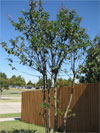Question and Answer – November 2008
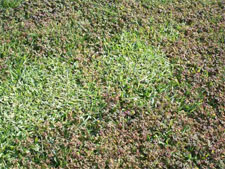
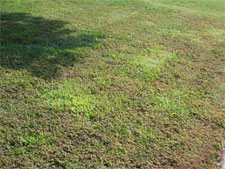
Question: After losing a tree in a storm last year, the portion of my yard that is sloping to the south is receiving more sunlight. The fescue that was there began to die out. I want to replace it with St. Augustine, since the other half of the yard is also St. Augustine. However, when I planted some sod last spring, it did not spread. Instead, weeds seemed to thrive. I cleared the ground and pulled the weeds before planting the sod, but it didn’t spread. It gets at least eight hours of sun each day. Any suggestions on how to get it to spread and/or get rid of the weeds? Or, should I consider another type of grass? J.B., Plano.
Answer: That’s enough sunlight. St. Augustine actually grows best in full, or nearly full, sunlight. If that’s the grass you prefer, you should be able to grow it. (It’s my grass-of-choice, too.) However, it does have a few issues that need to be identified, then dealt with if and when they arise. We have posted them on our website’s Most-Asked Questions pages. One you should begin with is Take All Root Rot, also known as Take All Patch. Click here to see my comments, many of them referring to my own lawn. Feel free to browse through the other questions and answers. Some of them may also come in handy.
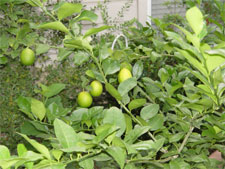
Question: Last year my Meyer Lemon tree produced approximately 100 lemons. I only have four this year. Is this an every-other-year tree? P.B., No city given.
Answer: Nut trees such as pecans and oaks are notorious for the alternate bearing you describe, but not citrus. Your plant may simply have overtaxed itself last year. If it didn’t look so healthy in your photo I would normally wonder if it needed better feeding or more water. Did it bloom well? Did it have insects to pollinate the blossoms? I hate to leave you with more questions, but those are things to think about.
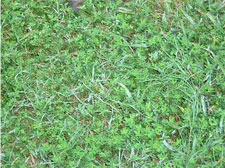
Question: I am enclosing a picture of a weed that appears in my bermuda and St. Augustine grass in the spring and fall. It seems to die out during the summer and winter. I have tried using 2-4-d on it in the bermudagrass with very little luck. What should I use in the St. Augustine and bermuda? B.W., No city given.
Answer: It looks like it could be the weed purslane. You have used the best herbicide for it, and honestly, it should have done the job. Repeat it as needed next year. You might try putting one drop of a liquid dishwashing detergent into the spray tank to help the spray hold onto the waxy leaves and stems. However, the biggest help will come from stepped up maintenance of your turf. Fertilize it regularly, and mow it short to keep it spreading. This weed really ought to disappear under that regime.
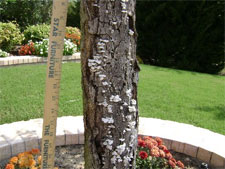
Question: My oak tree has a portion of the trunk that is dead, maybe 5 or 10 percent of the trunk width, and has white looking fungus on part of the dead surface. Should I peel off the dead bark and paint the surface beneath? The affected trunk portion is 18 inches around at the bottom (12 inches above the flair), 12 inches around at the top dead portion, and 3-1/2 feet long. The dead wood does not appear to be more than 2 inches deep. The tree is about 20 feet tall and otherwise healthy looking. B.I., Fairview.
Answer: This doesn’t look good, but hopefully the tree is producing new bark beneath the dead portions. Look very carefully for a roll of the new growth coming in from the sides. Do not peel any of the bark away. For the record, an arborist would be able to give you the best diagnosis by looking at the tree and consulting with you on-site.
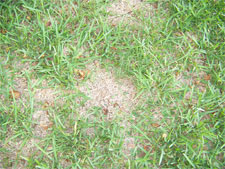
Question: We have St. Augustine in most areas of our yard. We fertilized it in the spring and watered it most of the summer, but in areas in the front yard where there is a great deal of shade, I have empty spots. There is just dirt in those places where grass once grew. I am now noticing that I am getting bare spots in the back yard also. I need your help, and I need it quickly. Without help, I will soon have a huge sand box. Thank you. C., No city given.
Answer: I don’t want to sound like a broken record, but Take All Root Rot (TARR) has become a very common problem in Texas. Please consult the link listed above. It really looks like that could be your problem.
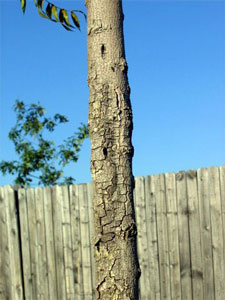
Question: Three years ago, we had this Chinese pistachio planted in the southeast corner of our back yard. In addition to the cracking bark, the leaves are constantly droopy, and it has experienced minimal growth. A windstorm blew it over shortly after it was planted, but the landscaper raised it back up and staked it. However, if you push on the trunk, you can see the base of the trunk moving back-and-forth. What can I do to help this tree get healthy and prevent further deterioration of the bark? Should I dig the tree up and replant it? Thanks for your helpful advice. A.S., Keller.
Answer: This is almost assuredly sunscald that happened in the tree’s first couple of years. It’s the reason that wrapping the trunks of new Chinese pistachios and red oaks is non-negotiable. It protects against both sunscald and borers. Nurseries and hardware centers offer it. Wrap from the ground up to the lowest branches, and leave it in place for 12 to 24 months. It’s too late to wrap this tree, but it does appear to be holding its own. Like the red oak above, hopefully you’ll see the roll of new bark forming. That would be evidence of healing. Many times, the best help we can offer is to do nothing ourselves. Professional arborists can be of a great deal of help in these situations.
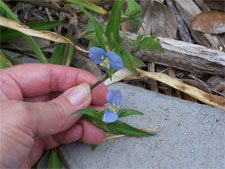
Question: What is this weed, and what can I use to get rid of it? B.K., San Angelo.
Answer: Your weed is spiderwort, from the dayflower family. It’s actually a close relative of wandering jew, the hanging basket plant. It’s a fairly weak-stemmed, but tenacious perennial weed. You should be able to get good control by using a broadleafed weedkiller containing 2,4-d. However, the weed tends to be rangy, so getting the weedkiller onto its leaves without letting it drift to adjacent plants will be the problem. I generally just hoe it out of my garden and mulch a little more deeply.
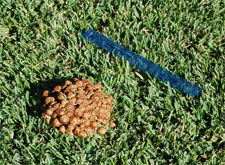
Question: In the past two weeks, mushroom-like growths have cropped up, mostly in mulched beds, but also in the lawn like the one pictured. Do I need to worry? C.H., Richardson.
Answer: No worry. Other than being one of the most disgusting-looking mushroom growths I’ve ever seen, funguses like this exist off decaying organic matter. They are not parasitic. The worst thing they will do is to smother the grass in the immediate area of the outbreak. They will come and go in fairly short order. Eventually, they run their course and the grass will be just fine. Use a hoe to pop it out of the way.
Question: What is wrong with my crape myrtle? It simply doesn’t look very good. J.C., No city given.
Answer: I’m not sure I can help without a few more clues. It looks like there might be black sooty mold on the leaves, but I really can’t tell from the more distant photo. If so, it’s probably the result of crape myrtle aphids that might have hit the plant late in the summer. There is no call to action this late in the season. A systemic insecticide would help stop the aphids, their honeydew and the resulting sooty mold next summer. For the record, it really helps to have each reader’s city. If you are on the north side of DFW, azalea felt scale might be involved. A few do appear in the closer photo. The same sprays would probably help.
It looks like your plant has been topped sometime in the past. Remember that we should never remove growth from the tops of crape myrtles. Click here to link into the "Pruning" section of The Crape Myrtle Trails of McKinney website.
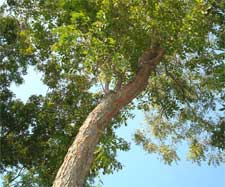
Question: What could be causing the bark of my soapberry tree to be falling off like this all the way up the tree? I have had this property for five years, and this is the first time this has happened. I saw several black/grey medium-sized bugs on it about a month ago and started killing them – some type of beetle. S., Dallas.
Answer: This may be soapberry borers. It’s a comparatively new insect pest to Texas gardeners, and Dr. Mike Merchant with the AgriLife Extension Service in Dallas prepared a news release on it three years ago. Click here to see his comments.
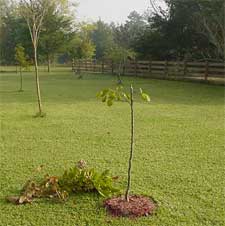
Question: Something is attacking my young Fuyu persimmon trees. Whatever it is, it’s cutting the limbs off near the trunk. This was the first year for one of them to fruit, and it has cut off all the top growth. Will it come back next spring? What’s causing it and what can I do? R.H., Huntsville.
Answer: Welcome to the world of twig girdlers. They’re actually fascinating insects, but their damage can be disfiguring. Click here for a link to the Texas A&M Fact Sheet on twig girdlers. You’ll see a photo of the pest, and you’ll see persimmons listed as one of the host species.
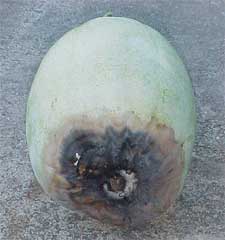
Question: I’ve had this "black spot" on my watermelons this summer and early fall. They are Charleston Greys, and they are being raised in a black clay garden soil. The plants themselves look great, but most of the melons develop these black spots when they’re small, on the end opposite the stem, then that end of the melon just shrivels up. Meanwhile, the stem end remains healthy. I currently have a few good ones that don’t have this issue, but most do. I don’t think there is anything stinging them either such as wasps. Is this a fertilizing, sun, pest, etc. problem, or what? T., Leonard.
Answer: This is blossom-end rot of watermelons, and it’s the same problem many gardeners face with tomatoes. In most cases, it’s due to the plants’ getting too dry between waterings. The blossom ends of the fruit, like the tips and edges of leaves, are the points farthest from the roots. As a result, they’re first to dry out and last to get water. Mulch your plants next year, and keep the soil uniformly moist at all times.
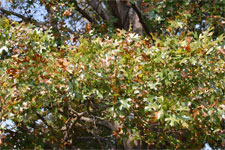
Question: About 10 days ago, the leaves on my red oak began turning and dropping. There is no sign of damage to the trunk and no excessive dead wood. Any ideas on what could be wrong or what can be done to save the tree? C.H., Richardson.
Answer: As late in the season as it is, this is probably just the tree’s reaction to recent warm, dry weather of the past 6 weeks. It seems, from your photo, that it’s happening uniformly over the entire tree. That would suggest that if there were a problem, it would be in the trunk or root system. You said you saw nothing. My vote is to wait until spring to see how it is doing. However, you may want to get a licensed arborist on the job immediately, before the tree loses any more leaves.
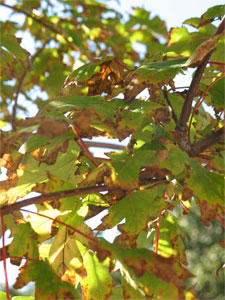
Question: This maple was planted by a professional last October. It is approximately 20-25 feet tall. It has a watering connection so that when the sprinkler runs, it gets water. I also deep water it every other month, more often when it was just planted. It gets overspray from the golf course watering since we live on a fairway. This summer, when it started having the leaves turn brown on the tips, we suspected it was the heat. However, it still continues to turn brown. It is pretty consistent all over the tree. Could you please advise? We have asked for some local help, but we haven’t gotten much. We do not want to lose this great tree. K., Lantanta
Answer: Wow! That’s a very large tree to be transplanting. The leaves are showing scorch caused by moisture stress. If you were relying on the sprinkler connection for most of its irrigation, that may not have been enough. Supplementing it only every other month would not have been enough of a boost to make a difference. Hopefully, it will come out perfectly next spring. Keep it moist until then. And, let your landscape contractor know of your concerns.
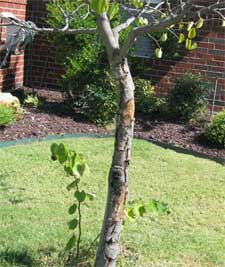
Question: What is wrong with my redbud? Its trunk looks terrible. J.C., no city given.
Answer: This is terrible bark loss, probably caused by sunscald. The interruption of moisture flow has caused the trunk to scorch. Wait it out. Hopefully, the tree can recover. However, it’s going to be a real uphill climb for it.


